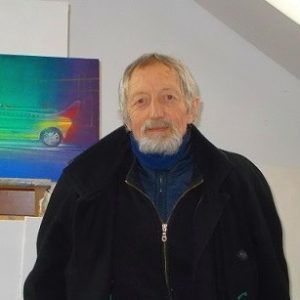
Gerard Tunney
Q&A
-
What inspires you and what is your creative process?
My experiences of the theatre had a huge influence on my work. I worked with a lot of different theatre companies, Royal Ballet, Royal Shakespeare, Opera North and because of this l painted ballet, Shakespeare, myth etc. It also included a series of fine art theatre residencies with Birmingham Royal Ballet, Opera North and Northern Sinfonia. These residencies produced a body work for a series of theatre-based exhibitions. The dominant pictorial themes that emerged in my work were transformation and change and the theatres' capacity to take the ordinary and transform it into something magical through the use of lighting, make-up, costumes etc. What I looked for in my work was the contrast between the figurative and the abstract and where these two visual ideas meet is where the painting begins. A subject that l paint repeatedly is ballet as it combines movement, energy, strength and grace and is an endless source of inspiration. l have also tried to extend these themes by looking for subjects elsewhere. This can mean painting subjects which may appear to be very different to the theatre such as horseracing/motor racing, the city, cars, reflections etc. But what they all have in common is this pictorial mixture of the figurative and the abstract.
These different subjects require a varied amount of source material. We live in an age of mass media; documentaries, travel, the internet, television etc. and this enables artists to have access to a wealth of material to reinforce their studio practice. This is something that was denied to artists from the past who certainly would have taken advantage of it, given the opportunity
-
What is/are your favourite medium(s)?
Oils were always regarded as the most demanding medium and it was my medium of choice for a lot of years but this was eventually replaced by acrylics. Acrylic has the sturdiness of oil paint but has the spontaneity of watercolour. Acrylic dries very fast so it enables me to move the painting and make changes very quickly and gives the work a freshness and spontaneity which is what l am trying to achieve. I still use oils but usually to just add the final glazes of a painting if l think it needs that extra jewel-like quality that oils provide.
-
Do you like to work on different pieces at the same time?
This depends on the subject. If I start a new group of paintings with a subject I am unfamiliar with, such as 'The city', it can take quite a long time trying to establish how to approach it. The solution might involve window reflections combined with several vanishing points which may sound obvious but can take quite a lot of trial and error before establishing this as the primary driving force of the work. Also, when I start a painting, initially I am looking for contrast and to a certain extent the painting grows from the paint. The next important thing is balance. So, a painting can go backwards and forwards before it is finally resolved. Some paintings can emerge quickly and others are a struggle.
Usually, l work on about 4 paintings together but if l am working on two different subjects this can increase to 8. If l am working on something like a residency or an exhibition this can increase to 30.
-
What other artists have been inspirational to you in your work?
Rembrandt for his technical brilliance and humanity. Titian for his vivid colour. Caravaggio for his breathtaking compositions and his chiaroscuro.
Edward Hopper is an artist who is a master of painting light and yet I have always felt that his painting of light is conceptualized. This is not meant as a criticism and l am guilty of the same accusation myself. The light in the theatre is an artificial light created by electricians etc. It is an abstract light and this enables me to feed off this artificial light and allow the concept of light to grow from the paint and the painting, and the question for me is what comes first, the painting or the subject. For me, the answer is that the painting always comes first and the subject has to follow. This gives me and my work the freedom to follow a route that is unpredictable and hopefully convey something of the élan vital.
Media
Projects & Collaborations
-
PROJECTS/NEW COLLABORATIONS
I am currently trying to develop a series of paintings that extend my interpretations of myth which is more contemporary and less classical. If we have learnt anything from Picasso it is the necessity to keep pushing the studio work in an attempt to discover new themes and ideas. It is because of this my work does not have a single subject but attempts to be as eclectic as possible. But I am also working on 4 ballet paintings and 3 horseracing paintings. So, at the moment, l am working on 11 paintings. Some of which I have some idea of how to complete, but others, less so.